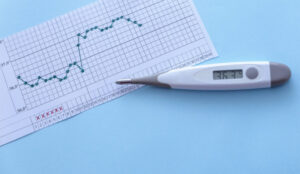 Michelle is becoming a pro at knowing when her most fertile days occur. She has been charting her basal body temperature (BBT) and signs of fertility for 3 months, and is feeling comfortable with understanding her body and what it is telling her. She loves seeing the pattern unfold each month on her fertility chart where she marks down her temperature every day.
Michelle is becoming a pro at knowing when her most fertile days occur. She has been charting her basal body temperature (BBT) and signs of fertility for 3 months, and is feeling comfortable with understanding her body and what it is telling her. She loves seeing the pattern unfold each month on her fertility chart where she marks down her temperature every day.
How Do I Use My Basal Body Temperature to Determine Ovulation?
Here are a few tips for charting your basal body temperature:
- Buy a digital basal thermometer
- Download a fertility chart, they’re free
- Place your thermometer right by your bed
- Take your temperature first thing every day at the same time
- Take your temperature the same way
You need a digital basal thermometer. It should retain your last recorded temperature until you read it. Use the same thermometer the entire cycle.
Find a fertility chart (aka basal temperature chart) that you like. You can download one online. It should have a section to make note of cyclical changes in your mucus and cervix, and things that may affect your temperature and fertility.
Place your thermometer right by your bed, within easy reach. You do not want to have to be active to find it. You want to take your temperature as soon as you wake up in the morning, ideally at the same time every day. Take it before you go to the bathroom or do anything at all. If you take it more than 30 minutes earlier or later, make a note.
Take your temperature in the same way and with the same thermometer throughout your cycle. The best choices are orally or under your arm. It is normal for the temperature under your arm to be about 1 degree F below your oral temperature.
Now you have your temperatures on your fertility chart what does it all mean?
- Before you ovulate your body is cooler
- After ovulation your temperature will rise and remain high
- Learn what your coverline is
- After 3 temperatures at least 0.2 degrees above your coverline, you have ovulated
- If you’ve had 18 days of high temperatures and no period, you are probably pregnant
Begin your fertility chart with the first day of your period. The time from the start of your period until ovulation is know as the follicular phase, and estrogen is the dominant hormone during this time. Your body is cooler during this time. Your temperature should be at least 97.5 degrees F during this time (oral).
You know you have ovulated when your temperature rises at least 0.2 degree F. Between ovulation and the beginning of your next menses is known as the luteal phase, and progesterone is the dominant hormone. This phase should last 12-16 days. Your temperature should stay above your coverline. If your temperature has been higher for 18 days and your period has not started, you are probably pregnant.
Your coverline is a line that separates your lower, preovulatory temperatures from your higher, postovulatory ones.
- Look for a rise in temperature of at least 0.2 degree F higher than any of your last six temperatures
- Locate the highest of the six temperatures before this rise
- Draw a line 0.1 degree F above this temperature. This is your coverline for this cycle.
What can affect my temperatures?
- Waking up early or late and taking your temperature at a different time
- Sleeping with your mouth open (if this is common, take your temp under your arm)
- Emotional excitement
- Illness, especially fevers
- Drinking alcohol
- The room is too cold or too warm
- Sleeping embraced with a partner or child
- Using a different thermometer
- Traveling
If any of these occur, make a note on that day of your fertility chart.
As you can see, your basal body temperature will not directly tell you when you ovulate. It does provide critical information to confirm that you have ovulated. Combine this information with the signs of ovulation (fertile mucus, cervix changes, ferning saliva, and LH surge) and you have very powerful knowledge to understand your own fertility. If you are not ovulating, you cannot get pregnant.
To Your Vibrant Health!
Veronica Tilden, DO
